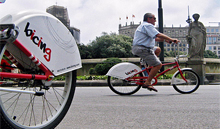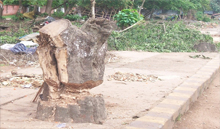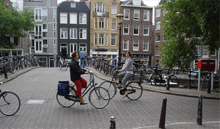THE BICING ON THE CAKE
By Piyush Ranjan Rout
Yes, public bicycle sharing schemes in cities worldwide ease traffic congestion. But that is not the sole plus they achieve. They also save lives and reduce greenhouse gas emissions and promote good health. Public Bicycle schemes are becoming increasingly popular in cities around the world, with more than 360 already running.
|
 |
|
A recent study by researchers at the Center for Research in Environmental Epidemiology in Barcelona found that around 9000 tonnes of carbon dioxide pollution was averted and 12 lives saved each year thanks to `Bicing’ scheme, which was introduced in March 2007. In two years, Barcelona’s Bicing had 182,062 subscribers, representing 11% of Barcelona’s municipal population. The average distance travelled by Bicing on a working day was 3.29 km with an average of 14 minutes.
The World Health Organisation (WHO) recommends adults should do at least 150 minutes of moderate exercise a week and says this could be done by walking for 30 minutes five times per week, or by cycling to work every day.
When I asked the Bicing promoters what was key to their success in Barcelona, her response was “Barcelona loves its citizens, so we promoted bicycle sharing systems for physical activity among the population and it is a good means to improve public health and also reduce expenditure on public health services, pollution. And above all, who doesn’t like to ride our Sleek Sexy Bikes instead of sitting inside a Fat Car.”
So perhaps sleek bicycles for Indian cities are one of the answers to decongest traffic, address obesity and make our citizens healthier. These bicycles sharing system will offer the public a green alternative to car share or auto rickshaws. Customers can pick up a bicycle from any bicycle sharing station, and then return it to any other station in the system.
But of course, the first step to set this up is to ensure Indian roads have space earmarked for bicycles.
|
| |
HOW MANY PANTS WILL WE BUY FOR OUR CITIES?
By Piyush Ranjan Rout
Look anywhere around in your city and you find road widening work going on in some part or the other, with trees lying on the side as martyrs. I remember a quote that I read somewhere that “Expanding roadways to accommodate traffic is a bit like combating obesity by buying large pants”. |
 |
|
When I mention this to my friends living in cities across the world, they tell me their cities are friendly to public transport system, walking, cycling, underpass etc.
When we chop down trees to facilitate road expansion and build flyovers, all to solve the mobility issues for a few, we forget that there are many others living in the same city, who have the same right to the city’s green lung.
But when the roads are expanded, are they used only for easy motoring? No. Instead the space is used for car parking or informal vending. Not a single zebra crossing is perfect, footpaths are virtually extinct. It is the same everywhere, be it Delhi, Mumbai, Hyderabad, Bangalore or Bhubaneswar. We keep on expanding, build multilevel flyovers but accidents still increase and mobility issues persist. Why?
Do we know even one city that solved its traffic problems by expanding roads or building flyovers? No, not even cities like Tokyo, New York or Seoul. Cities all over the world are repenting the mistakes they made and dismantling infrastructure they have build in the past.
A long time ago, advanced cities such as Manhattan, London, Paris and Zurich decided they will not build more road infrastructure or elevated corridors in order to alleviate traffic jams.
The city of Seoul once build multilevel flyovers over Cheonggyecheon River to solve its transport problem. But instead of solving its problem, the city lost its historical river and created more problems. The present South Korean President Myung-bak Lee during his tenure as Mayor of Seoul, brought back the river by demolishing the flyovers. Today the place is not just a tourist attraction but also a location for Bollywood movies.
Seoul is not the only example that prioritises walking, public transport over cars. The Mayor of Bogota in Colombia, Enrique Penelosa diverted an international fund for roads towards creating pedestrian paths and Bus Rapid Transit System. Similarly Ken Livingstone, former Mayor of London introduced congestion cess on driving cars during peak hours in central London.
A city belongs to its people. Then how is it that we design a transport system without knowing what kind of city we want. Why not structure the parts of cities yet to be built as a pedestrian and bicycle street network, hundreds of kilometers long.
Our cities cannot be only for the powerful minorities and their cars.
|
| |
DID YOU RIDE TO WORK TODAY?
By Piyush Ranjan Rout
A great city is not guaged by its buildings or freeways but by whether a child is safe on a bicycle or a woman can easily walk on the streets. However, many of our cities are designed and planned to facilitate cars. How long will we managing our cities like this? Do we want our cities to run only on cars? |
 |
|
Our politician always remembers a bicycle ride to demonstrate rise in fuel price. The same politician never forgets to return home in a luxury car. I don’t understand why our politicians every time want to show the bicycle as a symbol of poverty, a vehicle of the poor. If they are so keen why not pull a Car without fuel and demonstrate and agitate.
A rise in petrol price really doesn’t make any sense to the user of the bicycle. Rather a bicycle symbolises a person’s concern for the environment and society. I will appreciate if our politicians ride a bicycle every day and set an example. The way we are growing, our country in any case, will not be able to afford to meet the fuel prices that it imports from around the globe.
If The Netherlands chosen to be the Bicycle City, it was not a decision of the technocrats but of the people and the politicians. Why can’t we build our cities to be more bicycle friendly or more people-friendly and walkable?
A safe cycle path is a symbol of democracy; it shows that a person on a $40 bicycle is as important as a person in a $40,000 car.
If we accept that only the poor ride bicycles, then we also need to re-visit our Poverty Index. So that a bicycle rider can be incentivized to get financial assistance similar to Below Poverty Line.
What we need today is better integrated city planning with investment in Bicycling Paths and Public Transport that can reduce pressure on fuel requirements. A good investment in Bicycling Paths and Public Transport can save between 25%- 45%. Moreover their use brings to the community, a sense of belonging, whereas cars tend to be a means of social differentiation.
|
| |
|

